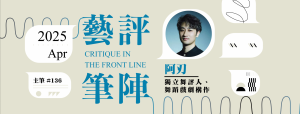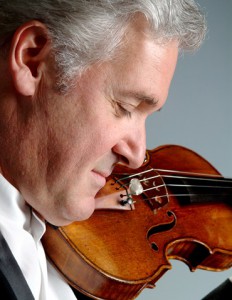 |
There is something language cannot afford. Dire tragedy and nearly every drastic human emotion, for instance, are more articulate when unspoken.
Even if Tang Shu-wing does not overtly agree with the thought, he has been creating works to that effect with movement and minimal theatrical devices. While presented as a verbal drama, Titus Andronicus 2.0 (2009) dispossesses Shakespeare’s most violent play of a realist setting and linear narrative and endows it with symbolic physical movements, which in turn transcend the text, much to the annoyance of Shakespeare purists. His collaboration with choreographer Xing Liang in Hong Kong Dance Company’s Princess Changping(2009) is perhaps his unwitting effort to mute a canonical work, which happens to be a tragic romance. Three years later, Tang and Xing make a conscious attempt to make Cao Yu’s epoch-making tragic play in modern Chinese theatre Thunderstorm, written in 1933, into a non-verbal, cross-genre (Chinese dance and theatre) work. The attempt would appear to be impertinent –not so much about the play’s classic status than its complex plot.
Forewarned of the intricate relationships inThunderstorm, I did my pre-show preparation watching Thunderstorm’s 1957 film adaptation, starring the legendary Bruce Lee (playing the 17-year-old Zhou Chong), the immortalised Cantonese film stars Cheung Ying (playing the Zhou Ping, Zhou Chong’s 28-year-old step brother) and Pak Yin (playing Zhou Ping’s estranged mother). Well aware of the story’s tragic magnitude, I, nevertheless, found myself on the verge of chuckling at certain points of the film. Therealist tragedy was reduced to a melodrama. It was the dialogue and the delivery, I soon realised. The characters’ extreme emotions were externalised; their tribulations undermined. I’d rather they be silenced.
By this observation alone, Tang and Xing’s non-verbal Thunderstorm was already partially successful before it was staged. Whereas their Princess Changpingtends towards a metaphorical and meta-theatrical interpretation punctuated by Tang and Xing’s voice-over commentary, the two artists keep their respectable silence in Thunderstorm and let the dancers’ actions speak for themselves.
That said, I didn’t enter the theatre to witness the entangled incestuous relationships unfold scene by scene, for it’s impossible, one must admit, without linguistic expression. Neither did I intend to gauge how effective Tang and Xing’s version to tell the story. I was only interested inhow they tell story. As the work’s artistic director, co-director and dramaturge, Tang presents the six key characters on stage: patriarch Zhou Puyuan; his former maidservant and long-lost illegitimate lover, Shiping, who is believed to be dead; their son Zhou Ping; Fanyi, Zhou Puyuan’s relatively young wife who once committed adultery with step-son Zhou Ping; Zhou Chong, 17-year-old son of Zhou Puyuan and Fanyi; Sifeng, a 18-year-old maidservant of the Zhou family, who, unbeknownst to anyone, is Shiping’s daughter with another man. Sifeng is in love with Zhou Puyuan, unaware that he is her blood brother, while her step-brother Zhou Chong also falls for her.
Such unspeakable interrelationships are only mildly hinted at in the prologue, preceded by the sound of murmuring rain. The six characters stand behind or sit on the sofa in tableau, as if posing for a family portrait. Then each moves slightly, one after another, in slow motion. Love, lust, forbidden passion, resentment and remorse, or perhaps everything at once, are embodied in that touch of hand, that gaze and those wriggling fingers. These subdued moves’ subtext, although known only to the action-takers and audience members who are familiar with the story, begin the story with eloquence.
The following five scenes (excerpts of pivotal turn of events in the play) take place in Tsang Man-tung’s earth tone, minimal set. The round dinning table, circular Chinese-styled shelves and the symmetrical European-design sofa add a subtle sense of irony to this broken family. Everyday actions, in real-time or theatrical slow-motion, are blended in Xing’s choreography, which is more expressive than narrative. For audience members who aren’t specialists in Chinese dance, it is hard to distinguish the various technical movements in each character’s solo. While each dancer displays his or her character’s convoluted psychological and emotional struggle with the body, their individual movements are not as distinctive as their unique position in the web of love and family ties.
The more memorable part, where drama and dance unite strikingly, is whenZhou Puyuan forces his eldest son (i.e. his wife’s erstwhile secret lover) to kneel, repeatedly, in front of his wife in order to coerce her to drink the medicine. Huang Lei, senior dancer of Hong Kong Dance Company, plays the 55 year-old Zhou Puyuan, who is at least 20 years Huang’s senior. Yet, the dancer’s innate composure makes up for his juniority in age for the role. An unsympathetic character throughout, Huang’s Zhou Puyuan does not captivate, even with his hysterical laugh, as much as Li Long-hin’s innocuous Zhou Chong. His ignorance to the goings-on behind the scene and his straightforward and unrequited love for Sifeng make him at once an optimistic and tragic character. Li, fresh HKAPA graduate, takes up his character with ease. Always running around and at times leaping into the air with energy and joy (even not exactly smiling, his mouth is always slightly open with happiness), Li, the only one in Western attire (a three-piece suit without jacket) symbolising the new and the future, brings a bitter contrast to the tragedy in the scene titled ‘Dance of Hope’.
Most would agree that no background music other than the sound of thundering and raining can beat a drama/dance conspicuously titled ‘Thunderstorm’. But composer and sound designer Mathew Ma outdoes such inherently dramatic sound from Mother Nature with a percussion-like track comprising discordant, if disturbing, sound of small objects dropping on the floor in the solo of Iris Sun, who plays maidservant Sifeng, in which she kneels and stands alternately under a rectangular spotlight.
Acquired with the power of silence, Tang strips music off the scenes where the visual have more to say than the audio. The roaring thunderstorm halts in the middle of the epilogue after the various degree of incests are exposed and confessed. The six characters stand motionless away from one another–no one is looking at the other face-to-face. All of a sudden, Sifeng collapses (in the story, she dies of electric shock in the thunderstorm), immediately followed by Zhou Chong (also dies in an attempt to save her) and then followed a moment later by Zhou Ping (who commits suicide), leaving their parents to face the aftermath. The thunderstorm resumes and continues after the blackout.
The fact that Tang presents Thunderstorm as a non-verbal work does not mean he disregards the text. Having an assistant dramaturge/playwright (Santayana Li) to translate the play’s dramatic actions into physical movements at the initial stage of the production, regardless of how much translation was of use to the dancers and choreographer eventually, shows Tang’s respect for what is written in the play. On the other hand, this production reminds us of how we sometimes overestimate the capacity of words. Even in a realist drama, we are never really touched by the spoken words. What touches us is the association or imagination they triggered. So why shouldn’t non-verbal movements have the power to do the same?
本網站內一切內容之版權均屬國際演藝評論家協會(香港分會)及原作者所有,未經本會及/或原作者書面同意,不得轉載。










